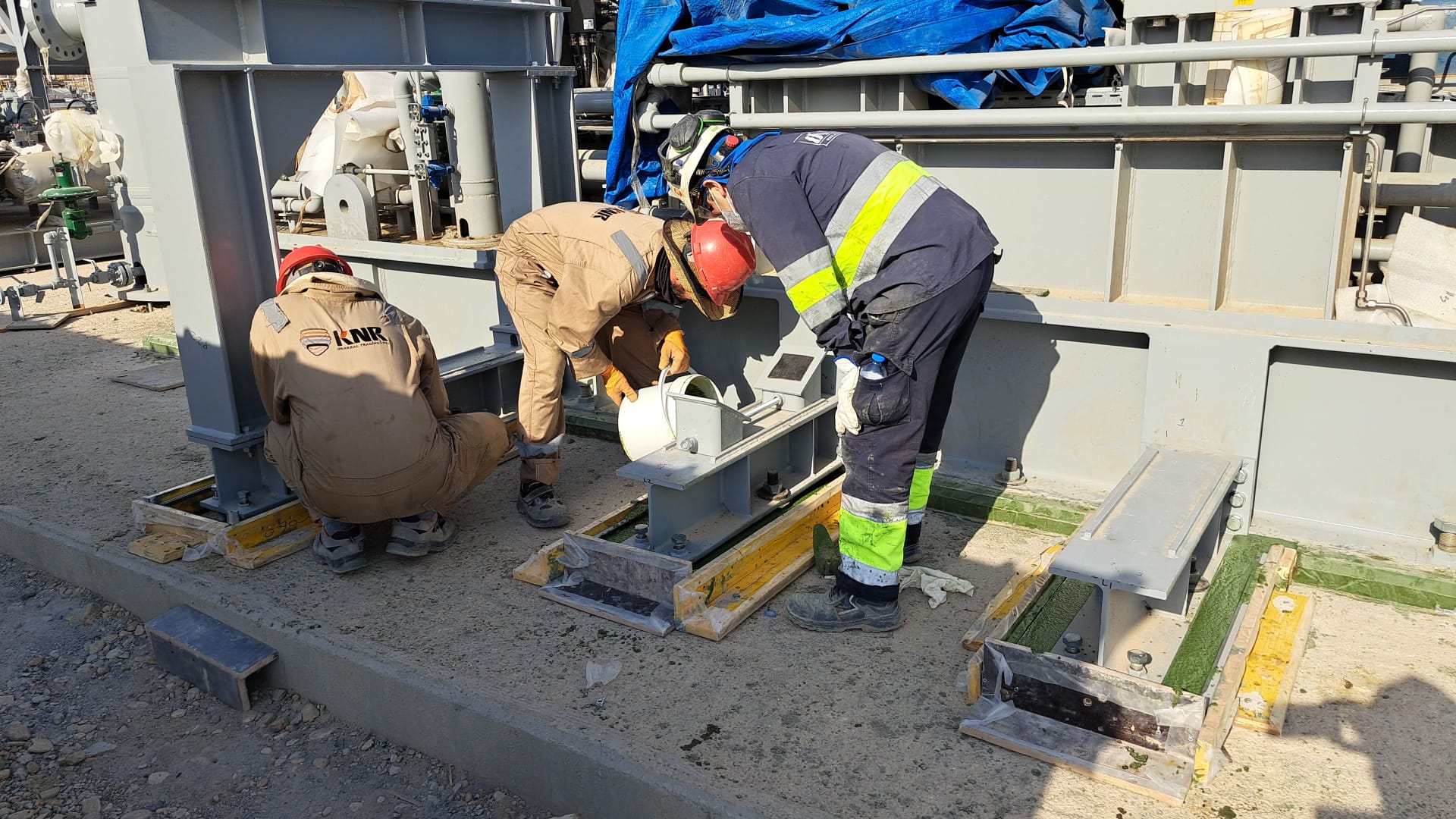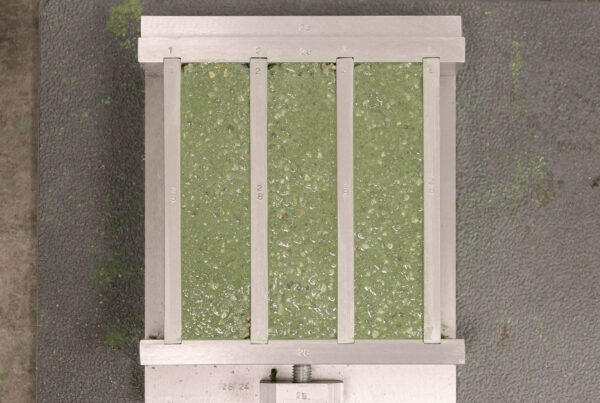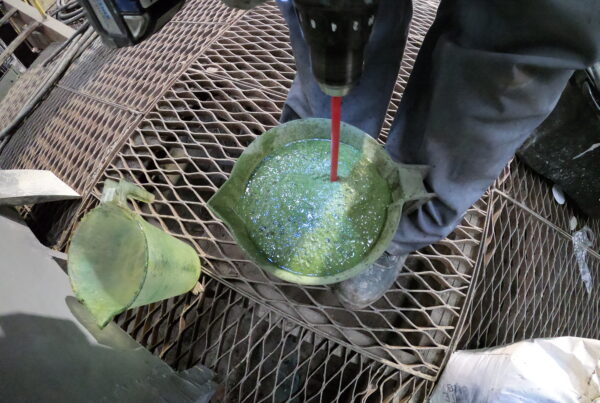When it comes to repairing and restoring machinery foundations, the epoxy grout application is a critical step. The process involves meticulous planning, precise execution, excellent understanding of engineering and adherence to specific guidelines to ensure a successful outcome. So what is involved?
Surface Preparation for Epoxy Grout Application
Surface preparation is a critical and indispensable step when it comes to the application of epoxy grout. It serves as the foundation for achieving a successful and long-lasting installation. The process begins by thoroughly cleaning the surface of the machinery foundation, ensuring the removal of any dirt, debris, oil, or loose particles that may be present.
The significance of proper surface preparation cannot be overstated, as it directly impacts the adhesion and bonding of the epoxy grout to the foundation. Without adequate preparation, the grout may fail to adhere effectively, leading to compromised performance and potential issues down the line.
To ensure optimal adhesion, it is essential to create a clean and contaminant-free surface. This allows the epoxy grout to penetrate and bond securely with the foundation, promoting stability and durability.
In cases where oil or grease stains are present, specialised degreasers or detergents may be necessary to ensure their complete removal. Additionally, stubborn or ingrained stains may require treatment with solvents or other suitable cleaning agents to achieve a pristine surface.
Once the cleaning process is complete, a thorough inspection is necessary to identify any remaining residues or contaminants. Addressing these issues promptly helps to avoid potential complications during the epoxy grout application.
Furthermore, it is crucial to allow the surface to dry completely before proceeding with the grout installation. Moisture or dampness can hinder the curing process of the grout and compromise its integrity. Various drying methods, such as air drying, heat lamps, or dehumidifiers, can be utilised to expedite the drying process.
Mixing the Epoxy Grout for Application
After surface preparation, the next step in the epoxy grout application process is mixing the grout itself. Following the manufacturer’s instructions is crucial during this stage. The recommended mixing ratio must be carefully followed to ensure the desired consistency of the grout. Achieving a consistent and homogenous mixture is essential for optimal performance.
Mechanical mixers are commonly used to blend the components thoroughly. This helps to disperse the materials evenly and prevent the formation of lumps or any unevenness in the grout. By using a mechanical mixer, the mixture can be properly combined, resulting in a smooth and workable epoxy grout ready for application.
Pouring and Levelling
After successfully mixing the epoxy grout according to the manufacturer’s instructions, the next step is pouring and levelling the grout onto the prepared machinery foundation surface. This process requires careful attention to ensure a proper and even application.
The mixed epoxy grout is poured onto the surface within the designated area, aligning with the repair requirements. It is essential to pour the grout evenly to achieve uniform coverage.
During this stage, precision is key. The grout should be distributed evenly to eliminate any gaps or unevenness. This helps to ensure the integrity and stability of the machinery foundation once the grout cures.
The levelling process involves working the grout with the tools to create a smooth and flat surface. It is important to pay attention to the thickness and consistency of the grout while levelling, as variations can impact the final results.
By pouring and levelling the epoxy grout with care and precision, a well-applied and visually pleasing surface can be achieved. This step sets the foundation for the grout to cure properly and provide the necessary support and stability for the machinery.

In-situ epoxy grout
Finishing Techniques
Once the epoxy grout has been poured onto the prepared machinery foundation, the next step involves implementing a range of finishing techniques to achieve a smooth and even surface. These techniques play a significant role in ensuring the grout is properly levelled and any excess material is removed.
Straightedges, screeds, or floats are utilised to level the grout and remove any excess material. These tools help achieve the desired thickness and contour, ensuring proper alignment with the machinery base.
Curing and Protection
After the application of epoxy grout, the curing phase begins. It is crucial to adhere to the recommended curing time and conditions as specified by the manufacturer. This ensures that the grout achieves its optimal strength and durability.
During the curing period, it is important to protect the newly applied grout from potential threats. Excessive moisture should be avoided, as it can interfere with the curing process and compromise the integrity of the grout. Similarly, temperature fluctuations should be controlled, as extreme temperatures can negatively affect the curing process.
Physical disturbances should also be minimised during curing. Any movement or heavy loads on the grouted surface should be avoided to prevent cracks or dislodging of the grout.
To safeguard the curing grout, appropriate protective measures can be implemented. This may include using plastic sheets or temporary barriers to shield the area from moisture, controlling the temperature environment, and clearly marking the grouted area to prevent accidental damage.
By ensuring proper curing and protecting the freshly applied epoxy grout, its strength, durability, and overall performance can be maximised, leading to a reliable and long-lasting support system for the machinery.
Post Epoxy Grout Application Inspection and Testing
Once the epoxy grout has fully cured, it is essential to conduct a thorough post-application inspection and testing to verify the quality of the repair. This step helps ensure that the grout has adhered properly and meets the specified requirements.
The inspection process involves assessing the bond strength between the grout and the machinery foundation. This can be done through various testing methods.
Additionally, a visual inspection is conducted to identify any potential voids, cracks, or imperfections in the grout. This allows for timely identification and rectification of any issues that may compromise the long-term performance and stability of the repair.
If any deficiencies are found during the inspection, necessary adjustments or touch-ups can be made to address them. This ensures that the grout repair meets the desired standards and provides the required support and stability for the machinery.
Conclusion
Alphatec Engineering has demonstrated exceptional expertise in the installation and repair of machine foundations with epoxy grout. Through their meticulous surface preparation techniques, accurate mixing and epoxy grout application processes, and attention to finishing details, Alphatec Engineering ensures a high-quality and reliable outcome for their clients.
With Alphatec Engineering’s exceptional capabilities in epoxy grout installation and repair, clients can have confidence in the durability, reliability, and performance of their machine foundations.



